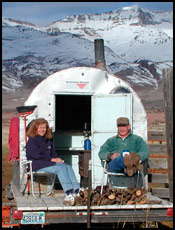
Ron Torell with his wife, Jackie.
Cow Camp Chatter
Replacement rate
A philosophy subscribed to by many ranches around the country is that great cow herds are culled, not bred. If a cow's calf is killed on the railroad, the cow is culled, for it was her fault for having the calf there to begin with.
This is a hard-line approach to building a great cow herd. It comes at the cost of a higher replacement rate and requires a refined management and genetic program, a balanced feed resource, and an economically viable operation with dedicated and well-educated managers. This higher culling rate allows the beef herd to make genetic progress at a faster pace in the areas of convenience and economically important traits.
Genetic progress is realized when replacement rates account for cows with bad dispositions, poor mothering ability, marginal or inadequate bags, bad eyes, lump jaw, dink raisers, and those that don't hold their flesh or are lacking in conformation. Professionals encourage a limited calving interval of 45-60 days, as well as elevated feedlot and rail performance. This sets the bar unrealistically high, especially for a desert range environment, and most certainly during drought years. If all the above mentioned criteria were included in a culling program, a replacement rate of 20% or higher would be required to maintain carrying capacity on a desert range environment ranch.
The best managed and most profitable ranches generally subscribe to selling all open and dry pregnant cows. If a cow does not trail home in the fall of the year with one calf following and another in utero, she herself becomes the paycheck. Generally a 10%-15% replacement rate is required to maintain stocking rates when following this "three-in-one package" culling criteria.
All cows are not created equal, which is self-evident by high fallout rates. Consequently, the quality of replacement heifers retained or purchased should be far superior to the market-ready cows (culls) they are replacing. Improving efficiency of a cow herd through culling is effective to a point; however, only if prudent bull selection is used to sire replacements.
It's unrealistic to expect different results when continuing to follow the same failed management and genetic program. Management and/or available feed resources of a ranch influence economically important and convenience traits. If a large percentage of cows often fall out of your program, consider a change in genetics and management or try adding additional resources to your ranch.
Higher replacement rates capitalize on the principle of the economic unit, which maintains that "it takes the same amount of annual inputs to feed a good one as it does a marginal or poor-producing cow." The average annual cow carrying cost for much of the west, including fixed as well as variable costs, ranges between $500 and $700 per head per year. Cattle-Fax data supports this figure and lists similar but varying input costs for other regions of the United States.
Each animal on your ranch should be viewed as an economic unit, including pet cows. Each fall, in spite of poor performance or a history of producing outlier calves, many pet cows avoid the terminal trip to McDonalds. It makes no economic sense why these cows are given a free pass based on sentiment, color pattern or simply an experience the owners had with the pet when it was a calf. None of these reasons justify fixed and variable carrying costs knowing a quality replacement animal could supersede the pet cow.
Counter to this discussion is the replacement strategy of retaining a higher percentage of heifers during poor market years and a lower percentage during high market years. The theory to this strategy is heifers retained during low market years will be producing calves during the high market years, resulting in a more profitable cow herd over time. This strategy certainly has validity and should be considered in the decision-making process.
Keep in mind, reduced heifer retention, even for a few years, requires lowering the bar on your culling protocol. Soon you have a lower-quality aged cow herd. A constant infusion of quality replacements is required to hold your cow herd to a higher standard of production.
If your ranch resources will only allow you to stock 250 mama cows, make them 250 good ones. Maintain a zero tolerance retention strategy. Replace those poor-producing economic units with cows that produce with the herd. First and foremost, remove the freeloaders.
Replacement rates are going to vary from ranch to ranch and from year to year. They are largely dependent on resources, management, goals and objectives, and the short- and long-term financial stability of a ranch. One thing is for sure, if cows have been given an adequate environment (such as health, reproduction and nutrition), a "three-in-one package" should be demanded every year. If you want a great cow herd, a stringent and unforgiving culling program is essential and will require a high replacement rate.
That's enough for this month. A special thanks to my wife, Jackie, for her part in writing "Cow Camp Chatter." As always, if you would like to discuss this article or simply want to talk cows, do not hesitate to contact me at 775-385-7665 or e-mail me.











